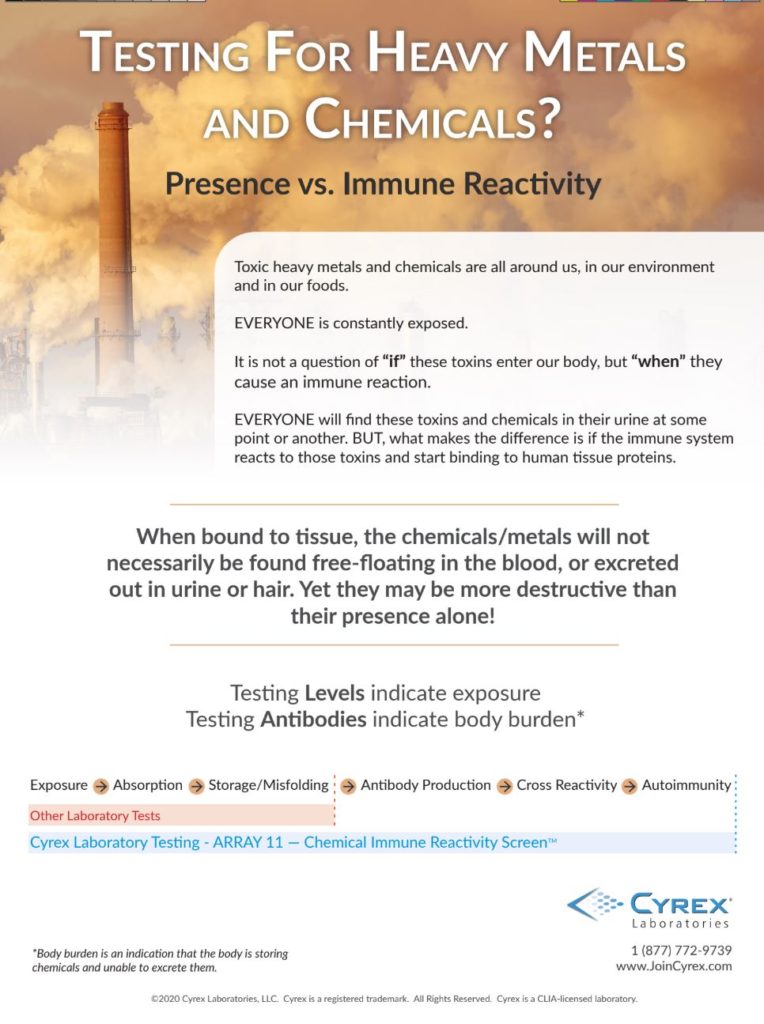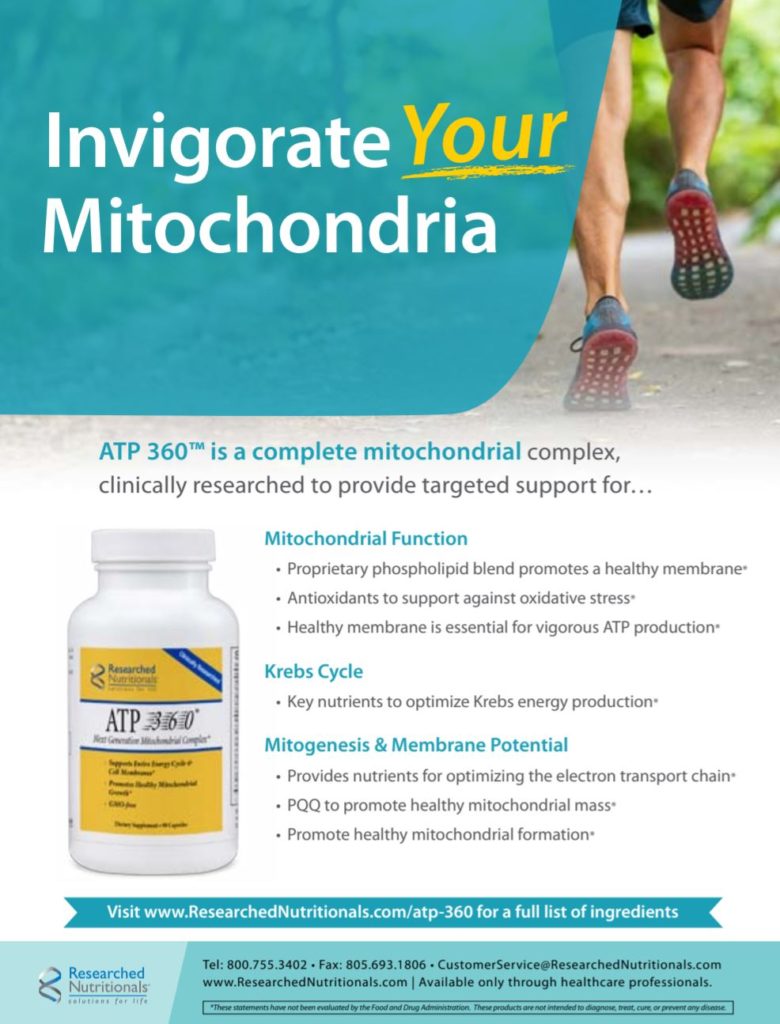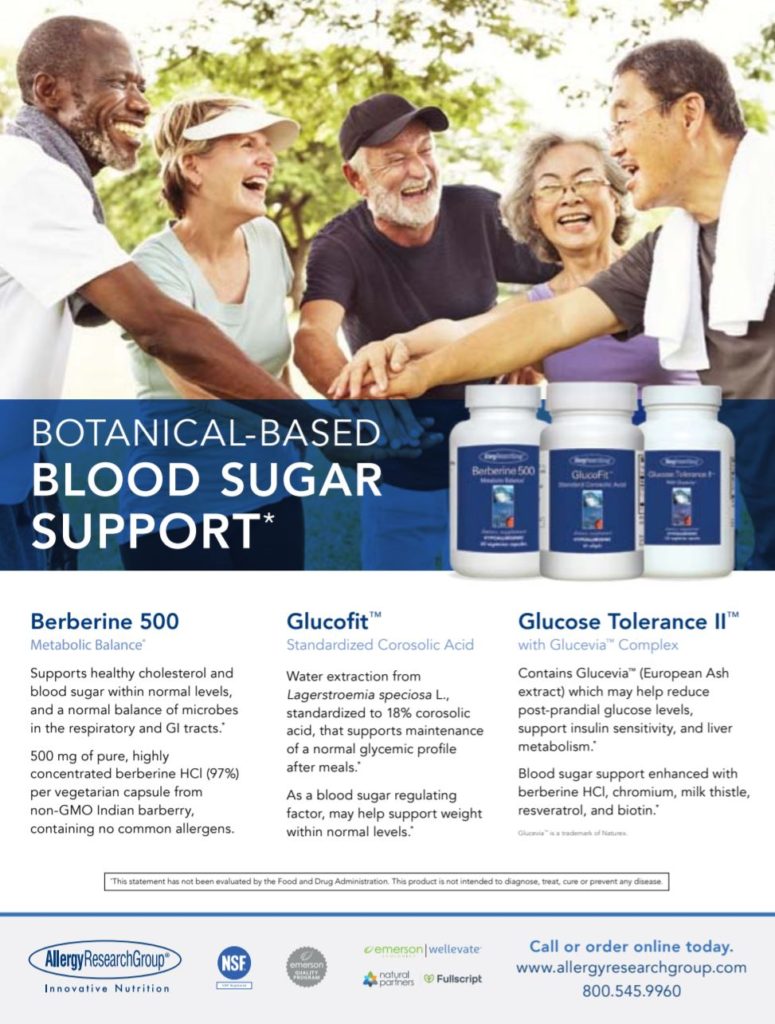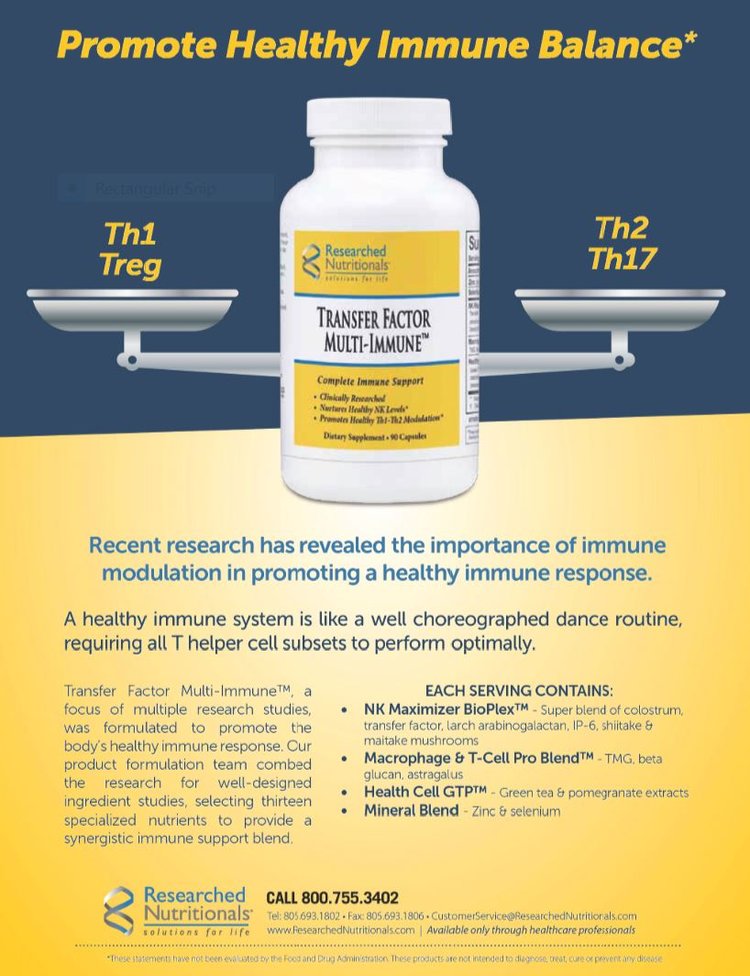by Marc Grossman, OD, LAc
Editor Note: In Part 1, published last month (Townsend Letter, April 2020), Dr. Grossman describes age-related macular degeneration, its risk factors, conventional treatment, and the role of diet. In Part 2, the conclusion of this article, Dr. Grossman focuses on nutrients and other ways to preserve vision.
Recommended Nutrients
Essential nutrients for the retina and macula include the following:
Lutein (6 mg-30 mg per day). Lutein and zeaxanthin are two similarly structured carotenoids that make up the macular pigment in the retina and help protect against damaging blue (visible) light as well as acting as powerful antioxidants. This pigment functions as a yellow filter to protect the light-sensitive photoreceptor cells (the cones) from light-originated (especially blue light) free radical damage. These carotenoids are also used in the lens of the eyes and act like internal sunglasses, protecting the eyes from damage against sunlight.1-5 Lutein has also been shown to reduce eye inflammation.6
Zeaxanthin (2 mg-12 mg per day).5 Lutein and zeaxanthin supplements are best taken separately from beta-carotene supplements because of competition for absorption. Lutein and zeaxanthin need fat to absorb well, so take them with food or a small amount of oil. The best time to take one of the dosages of lutein is before you go to bed.
Omega-3 fatty acids (2,000 mg-3,000 mg per day). Omega-3 fatty acids, found in fish, are a primary component of retinal photoreceptors and of the myelin sheath that surrounds nerve fibers in the eye. DHA (a type of omega-3 fatty acid) has been found to have antioxidative, anti-inflammatory, anti-apoptotic, and anti-angiogenic (limiting growth of new blood vessels) effects.3,7-11
Vitamin D3 (2,000 IU-5,000 IU per day). Numerous studies have found that low levels of vitamin D3 in the body can be connected to an increase in the presence of macular degeneration.12,13
Astaxanthin (6 mg-12 mg per day). Astaxanthin has been shown to be effective in protecting against damage from light due to its antioxidant effect.14 Astaxanthin destroys the unstable molecules called reactive-oxygen species (ROS), commonly known as free radicals, and wards off their constant attack towards all parts of the body.15 It helps slow down oxidative damage and protect the photoreceptors.16 Astaxanthin is a fat-soluble carotenoid which, in its value as an antioxidant, is ten times more powerful than beta-carotene, lutein, or zeaxanthin, and from 60 times to 500 times stronger than vitamin E. It must be taken in through food or in a supplement since it is not made by the body. For best absorption, astaxanthin should be taken with a healthy fat. Some astaxanthin supplements contain some fat in their formulation. In addition, in one study subjects fed 2 mg astaxanthin also showed lower plasma C-reactive protein concentrations, demonstrating the anti-inflammatory action of astaxanthin in humans.17
Meso-zeaxanthin (10 mg) is a carotenoid in the lutein family.18 Studies show that supplementing with meso-zeaxanthin helps protect central vision for those with AMD. One study done on 2007 found that levels of all three carotenoids (lutein, zeaxanthin and meso-zeaxanthin) increased blood and macular pigment density.19
Trans Resveratrol (175 mg per day). This potent antioxidant helps protect retinal cells from damage,20 reduces oxidative damage,21,22 and supports a healthy inflammatory response.23 It also maintains the health of existing blood vessels while suppressing the growth of new ones (angiogenesis), similar to the neovascularization that can affect those with diabetic retinopathy. It reduces retinal pigment epithelial (RPE) cell degeneration, leading to malfunction of blood-retinal barrier and loss of vision.24
Grape seed extract (300 mg per day) helps to strengthen blood vessels, maintain healthy platelet function and other aspects of platelet responses,25 and protects the central nervous system from reactive oxygen species.26
Vitamin C (buffered: 2,000 mg-3,000 mg per day). As an antioxidant, vitamin C scavenges free radicals in the body and protects tissues from oxidative stress.27,28
Saffron. Studies have shown that saffron helps protect photoreceptor cells from damage and support healthy circulation in the retina.29-34
In addition to these essential nutrients, daily home sessions of microcurrent stimulation (MCS) are recommended. The MCS 100ile unit is the most researched unit used for retinal health related to AMD. Five research studies have been done to date showing MCS as a method to daily support retinal and photoreceptor health in three ways: 1) supports healthy circulation to the retina; 2) increases energy (ATP) production within the retinal cells; 3) helps the retina eliminate waste.35-40
Other very important nutrients for eye health include the following:
Bilberry (120 mg-180 mg per day). Bilberry extracts have been shown to help night time vision and have potent antioxidative properties that not only are neuroprotective, but they also help suppress photooxidative processes and have been shown to improve microcapillary circulation.41,42 Bilberry is helpful for macular degeneration because it protects the retina against oxidative stress resulting from free radicals.43
Gingko Biloba (120 mg per day) helps support healthy circulation to the eyes and body overall and helps maintain the normal function and tone of blood vessels.44-46
Glutathione (500 mg – 900 mg per day) is a potent antioxidant shown to help protect retinal cells from damage. Best taken sublingually as it is not well absorbed through the capsules or tablets.47,48
Taurine (750 mg-1,000 mg per day) is a potent antioxidant found in the retina and essential in helping the eyes eliminate waste. It also enhances the rods and cones within the retina that serve as visual receptors.49
Lycopene (3 mg per day). Persons who had the lowest serum levels of lycopene, which is the most abundant carotenoid in the serum, were twice as likely to have macular degeneration when compared to those with the highest levels.50
Melatonin has prevented destruction of cells in the retina, including retinal neurons.51 And a research study showed this combination of melatonin (3 mg), zinc (8.7 mg) and selenium (50 mcg) taken before bedtime helped stabilize AMD, with some remarkable improvement in the fundus of the eye after taking the supplement for six months. (This is all in the Dr. Pierpaoli formulation.)52
Helpful foods and nutrients include the following:
- Green tea (500 mg – 750 mg per day)53,54
- CoQ10 (100 mg – 200 mg per day)55,56
- Selenium (200 mcg per day)57,58
- Dietary enzymes to increase glutathione synthesis, which can prevent free radical-induced apoptosis (cell suicide) and may help prevent or treat AMD.
- Goji Berries: A study found that daily supplementation with the milk/goji formulation increased the levels of zeaxanthin in the blood and protected from additional drusen formulation or loss of pigmentation.59
- Quercetin (250 mg-500 mg per day) has been found to be helpful through its antioxidant capacity to protect retinal pigment from oxidative stress caused by solar radiation.60 For wet macular degeneration, quercetin was also found to inhibit formation of extra blood vessels as well as improve blood flow in the choroidal layer of the retina.60
- Rutin (500 mg per day) combats inflammation and oxidative stress involved in the development of macular degeneration. Furthermore, research has indicated that rutin reduces leakage from the tiny retinal blood vessels and combats inflammation.61
- Curcumin (400 mg per day) has been shown to inhibit VEGF and cell death and is of great interest to researchers.62 In other research, curcumin has been found to have a protective effect against cell damage in human retinal pigment cells caused by blue light. The conclusion was that curcuminoids may have potential in AMD treatment.63 This research corroborates earlier studies.64
- Dark Chocolate (the darker the better) contains high amounts of epicatechin which has been found to have found to have three times the antioxidant value of green tea. One of the primary benefits of epicatechin is that it is a powerful antioxidant and because it can cross the blood-brain barrier it can be delivered directly to the brain (as well as reaching the optic nerve and retina.65
More About the Nutrients
Essential Fatty Acids (EFAs). EFAs are just as essential to a healthy balance of body chemistry and proper cell function as good food, vitamins, and minerals are. They are an integral component of nerve cells, cell membranes, and vital hormone-like substances called prostaglandins. Prostaglandins help regulate numerous body functions, including normal immune response during inflammation. Unsaturated fatty acids are also necessary for healthy skin, hair, and nails; they have a supportive effect on the circulatory system and can reduce blood cholesterol levels. Good food sources of unsaturated fats include nuts (almonds, macadamia nuts, hazelnuts, pecans, cashews), avocado, peanut butter, walnuts, sardines, seeds, salmon, olives, flaxseed, fatty fish (salmon, tuna, mackerel, herring, trout, sardines, anchovies), and other seafoods, including oysters and mussels. Olive oil (organic, first cold pressed) is a great oil for use in salads and dipping with bread. Olive oil can be used for cooking, but it should not be cooked at high temperatures. The best oils for cooking are saturated fats such as grass-fed butter, avocado oil, or coconut oil. Vegetable oils have a much higher omega 6 to omega 3 ratio, which can lead to health problems. Both omega 6 and 3 use the same conversion enzymes. So, higher levels of omega 6 from vegetable oils in the body convert to inflammatory eicosanoids and reduce the conversion of omega 3 to anti-inflammatory DHE/EPA.66
Omega-3 fatty acids are a specific type of EFA known to reduce inflammation and lower risk of chronic diseases such as heart disease, cancer, and arthritis. They are so essential to the retina that when omega-3 levels begin to fall, the retina begins to recycle them within the eye. Omega-3 fats are essential for nerve conduction in the retina and for reducing cholesterol; this keeps retinal blood vessels open, helping to maintain retinal nutrition. The typical American diet is deficient in omega-3 fatty acids, whereas omega-6 fatty acids are generally plentiful due to a high intake of vegetable oils and refined grains, which includes white breads, white rice, and white pasta. The best sources of omega-3 fatty acids are cold-water fish such as salmon, herring, and mackerel as well as black currant seed oil, flax seeds and flax seed oil, and chia seeds. Other plant-based sources of omega-3s are walnuts, fresh basil, grape leaves, spinach, cauliflower, arugula, Romaine lettuce, as well as Boston and bibb lettuces, certain beans (pinto, kidney and soy), Brussels sprouts, and tofu.
Vitamin D3. Researchers have found that low levels of vitamin D3 in the body are connected to an increase in the presence of macular degeneration. Studies also showed that supplementing with vitamin D could lower AMD risk in women who were younger than age 75.
Astaxanthin is a powerful antioxidant in the eyes that helps to prevent damage due to exposure to sunlight, reduces DNA damage, and in many ways is more powerful as an antioxidant than vitamin C, vitamin E, and beta-carotene. Other overall health benefits include being a natural anti-inflammatory, boosting the immune system, reducing the risk of certain types of cancer, protecting cardiovascular health, supporting skin health, and increasing muscle recovery after exercise. Foods that contain astaxanthin include krill, algae, sockeye salmon, red trout, red seabream, shrimp, crabs, lobster, crawfish and salmon roe.
Bilberry. Forty years of research confirm bilberry’s benefits for the eyes. Nicknamed the vision herb, it contains high amounts of anthocyanins, which improve the delivery of oxygen and blood to the eye, help maintain the integrity of capillaries, and help stimulate the production of rhodopsin, needed for night vision. The antioxidants contained in bilberry strengthen collagen and promote the health of tissues. Studies show that the high content of anthocyanins are a class of compounds in the flavonoid family (plant compounds that are found in almost all fruits and vegetables) with antioxidant benefits that are found in many fruits and vegetables and are responsible for giving these plants red, purple, and blue coloring. Bilberry is also rich in tannins, which are astringent in nature and have anti-inflammatory properties.
Meso-zeaxanthin is a carotenoid similar to lutein and is found in the center of the macula where we get our most detailed vision. It is found in microalgae and sea creatures that consume the algae, such as salmon, shellfish, and krill. A 2015 study showed supplementing daily with meso-zeaxanthin significantly increased macular pigment (found to be compromised in those with macular degeneration).
Ginkgo biloba. A double-blind study conducted by scientists in France in 1986 found that Ginkgo biloba could help people with macular degeneration, possibly due to its benefit of improving blood circulation to the brain.
Taurine is an important amino acid needed for the maintenance of vision, and the regeneration of worn-out tissues of the visual system. Taurine is found in high concentrations in the retina, especially in the photoreceptor cells where it protects cells from ultraviolet damage. Studies have shown that when taurine is removed from food, animals develop retinal degeneration; this is reversed when taurine is replaced. Taurine is also an essential nutrient in helping to remove waste deposits formed in the back of the eyes from exposure to sunlight. Unfortunately, taurine concentration in our cells decreases as we age. Food sources of taurine include fish, such as salmon, tuna, sardines and shellfish, beef, lamb, dark chicken meat, eggs, most dairy products, seaweed, krill, and brewer’s yeast, human breast milk, sea algae and plants. Organ meats such as liver and heart contain more taurine than choice cuts of flesh.
Resveratrol is a powerful antioxidant that helps protect against oxidative stress in the eyes. It also has natural anti-inflammatory benefits and aids in protecting the endothelial lining of the arteries, both in the eyes and throughout the body. The trans-resveratrol version is easily absorbed and is often included with Japanese knotweed root in formulas. Resveratrol increases NAD+ which is important for mitochondrial health and ATP energy production (which is what fuels our cells).
Selenium may help prevent oxidative damage in the retina along with zinc; it was included in the AREDS studies.
Zinc is found in high concentrations in the eye, especially the retina and its underlying tissues. Zinc helps bind the protective pigment layer of the retina to the underlying tissue. Supplementing with zinc has been shown in the AREDS studies to help support retinal health for those with AMD (along with other nutrients included in the study).28 Zinc also plays a vital role in bringing vitamin A from the liver to the retina in order to produce melanin, a protective pigment in the eyes. Zinc is highly concentrated in the eye, mostly in the retina and choroid, the vascular tissue layer lying under the retina.
Green tea is high in antioxidants called catechins that along with vitamin C, vitamin E, lutein, and zeaxanthin help protect the delicate tissues in the retina. Catechins are classified as flavanols (a distinct group of compounds within the flavonoid family and the predominant flavonoids in tea, red wine and cocoa) and act as antioxidants in the body, helping to neutralize free radicals.
CoQ10. Researchers reported that CoQ10 may improve the function of cell tissue in the retinal pigment, which, in turn, improves the function of the retina in those with age-related macular degeneration. In another study, CoQ10 has been shown in research to increase visual acuity and to reduce drusen in those with macular degeneration.
Pycnogenol and/or grape seed extract contain powerful antioxidants called proanthocyanidins that are many times stronger than vitamin E and vitamin C. Proanthocyanidins have potent free radical scavenger ability. They also strengthen capillaries, arteries, and veins, improve circulation, reduce capillary fragility, and reduce nerve damage in the eye. In his 1993 book, The Superantioxidant, Richard Passwater mentions studies that have shown that pycnogenol improves visual acuity and the functioning of the retina, especially in cases of retinal damage caused by microbleeding of the eye capillaries due to blood sugar imbalances.
Vinpocetine is an extract from periwinkle seeds that helps increase retinal circulation. In one study, 100 people with atherosclerosis and eye disorders were given vinpocetine. Eighty-eight responded with increased retinal circulation and improved visual acuity. Vinpocetine has been shown to support healthy circulation to the retina and brain and is a popular herb used in Europe to help with stroke prevention and memory enhancement. By increasing blood flow and stepping up concentration of ATP (the energy carrying molecules of our cells), vinpocetine improves utilization of glucose and oxygen in the brain and the retina. It also inhibits abnormal platelet aggregation, improves red blood cell elasticity, and inhibits an enzyme (GMP) that causes arterial constriction and blood flow reduction. Thus, arteries relax, blood pressure normalizes, and blood flow increases. In clinical studies, vinpocetine has been shown to benefit depression, headaches, short-term memory, inner-ear conditions, tinnitus, vertigo, menopausal symptoms, insomnia, speech impairment, stroke, and eyesight disorders.

Vitamin A (also called “Retinol”) is required for the formation of the photoreceptor rhodopsin, which acts as a regulator of light-activated photochannels (essentially enabling us to see by providing a mechanism for the photoreceptor cells to pass light to the optic nerve which then goes to the visual cortex in the brain.)
Vitamin E. Studies indicate that vitamin E reduces the progression of both AMD and cataract formation. Vitamin E also plays a significant role in the immune system, the health of cell membranes, DNA repair, and in other metabolic processes. Vitamin E can be found in high amount in nuts, fortified cereals, and sweet potatoes.
Note: Many eye doctors recommend taking an AREDS formula, based on two studies showing that supplementing with this formula can reduce the risk of advancement of macular degeneration. The Age-Related Eye Disease Study (AREDS), sponsored by the federal government’s National Eye Institute, determined that taking high levels of antioxidants and zinc could reduce the risk of developing advanced age-related macular degeneration (AMD) by about 25 percent. Research has shown that targeted, therapeutic doses of certain supplements not only reduce the risk of macular degeneration but may prevent additional vision loss as well as potentially improve vision in people who already have AMD. As many of these formulas contain food coloring and fillers, we prefer these nutrients, instead, be ingested as part of a whole food, organic multivitamin.
Although genetic testing is available now to help determine one’s risk of getting AMD, there has been some controversy among eye care professionals as to whether genetic testing should be done in at-risk patients with certain genetic polymorphisms (CFH and ARMS2). It has been suggested that certain patients actually do worse with zinc supplementation. In 2015, the recommendations from Bascom Palmer stated there was not enough evidence to recommend routine genetic testing when considering supplementation. Dr. Stuart Richer, lead researcher in the last lutein antioxidant supplementation trial, recommends the use of lower amounts of zinc (less than 50 mg daily), determined to be as effective as taking higher doses. He also recommends that genetic testing be offered to monocular patients (where one’s two eyes see near far distance differently) to avoid the possibility of a zinc hyper-immune response that is a possibility in one out of seven of all high-risk AMD patients.
Good food sources for zinc include red meat, seafood, poultry, eggs, pumpkin seeds, wheat germ, mixed nuts, black-eyed peas, tofu, and baked beans.
Self-Help Tips
The following are additional measures to prevent or treat macular degeneration.
Sunglasses should be worn outside in bright sunlight. They should be 100 percent UVA and UVB blocking lenses with wrap-around sides. Amber or brown lenses are the most effective colors for neutralizing the blue light spectrum, which is as potentially damaging as UVA and UVB light. Wear sunglasses along with a three-inch brimmed hat.
Aspirin thins the blood, so some doctors recommend it for improving blood flow to the retina; but several studies have shown that aspirin actually can cause macular degeneration through retinal hemorrhages.67 Therefore, try to avoid aspirin, particularly if you have a family history of macular degeneration.
Exercise regularly; exercise does so many things to affect the health of the body, including increasing circulation, which promotes the health of the body, including the eyes.
Eat a diet moderate in fats; high fat levels can disturb proper balance of gut bacteria essential for proper digestion and overall health.68,69 This also includes keeping polyunsaturated fats to a minimum,70 limiting refined carbohydrates,71 and eliminating any trans-fatty acids in one’s diet, which can increase cholesterol levels and inflammation, both of which affect the eyes’ blood vessels.
Drink plenty of water. Adequate hydration is essential. Spring water without chlorine or fluoride is the best. Sip water throughout the day and do not rely on feeling thirsty before drinking.72 At the point you feel thirsty, your body is already dehydrated. Neurological changes start occurring when there is a 2% drop in total body water. Also, certain eye diseases as well as general health diseases have been associated with dehydration.73
Avoid or severely restrict sources of non-native electromagnetic frequencies (nn-EMF). Higher EMF exposure leads to hypoxia, dehydration and inflammation.74 Turn off all wifi signals at night such as the internet modem, wireless printers, cell phones, computers, etc.
Reduce exposure to artificial blue light from computer screens, cell phones, LED and fluorescent lighting. Even low levels of blue light (400-470 nm) exposure may induce photoreceptor and retinal pigment epithelial cell damage. Light-induced damage also increases with age due to a decrease in protective enzymes such as superoxide dismutase (SOD). Artificial blue light exposure appears to be more damaging at night than during the day.75 Dr. Celia Sanchez-Ramos from Madrid’s Complutense University found that blue light permanently damages retinal cells and once damaged they cannot regenerate. Replace all fluorescent and LED lighting with incandescent bulbs. Other lighting options include beeswax candles and Himalayan salt lamps. There are blue light blocking glasses (ex: Blu-Tech lenses or complete protection BP1550 tints) that can be worn while on the computer, as well as blue light blocking programs that can be downloaded onto your computer and phone.
Ground yourself as much as possible by allowing any part of your body (bare skin) to directly touch the ground. This allows access to the earth’s abundant negative ions that can protect us from free-radical-induced inflammation and cellular damage. Grounding connects you to the Earth’s magnetic field and can protect your body from man-made EMF, UV light, and cosmic radiation.76
In summary, proper diet, nutritional supplementation, and lifestyle improvements, including regular exercise and stress management are fundamental to any preventive program, or as an adjunct to treatment, for macular degeneration. Macular degeneration is a difficult disease to control, and we need to incorporate the best of current knowledge in nutritional support and supplementation.
In addition to the measures presented in this article, there are several adjunctive treatments that can help people protect their vision, including eye exercises, Chinese herbal medicine and acupuncture, homeopathic formulas, essential oils, chelation therapy, hyperbaric oxygen therapy, and IV nutrient therapy. These topics and more are covered in my book Natural Eye Care: Your Guide to Healthy Vision and Healing.

Since 1980, Dr. Marc Grossman has helped many people maintain healthy vision and even improve eyesight. He is best described as a holistic eye doctor, dedicated to helping people with conditions ranging from myopia and dry eyes to potentially vision threatening diseases such as macular degeneration and glaucoma. His combined multi-disciplinary approach using nutrition, eye exercises, lifestyle changes and Chinese medicine provides him with a wide array of tools and approaches to tackle difficult eye problems.
Dr. Grossman founded the Rye Learning Center in 1980, a multidisciplinary center for learning problems, in 1996 co-founded Integral Health Associates in New Paltz, New York, and in 1999 co-founded Natural Eye Care, Inc.
His background includes degrees in optometry, biology, physical education and learning disabilities, coupled with yoga, bioenergetics, nutrition, Chinese medicine and acupuncture, the Alexander Technique and Feldenkrais. This orientation provides the foundation for an integrated approach to vision and its influence on the body, mind and spirit of each individual patient.









